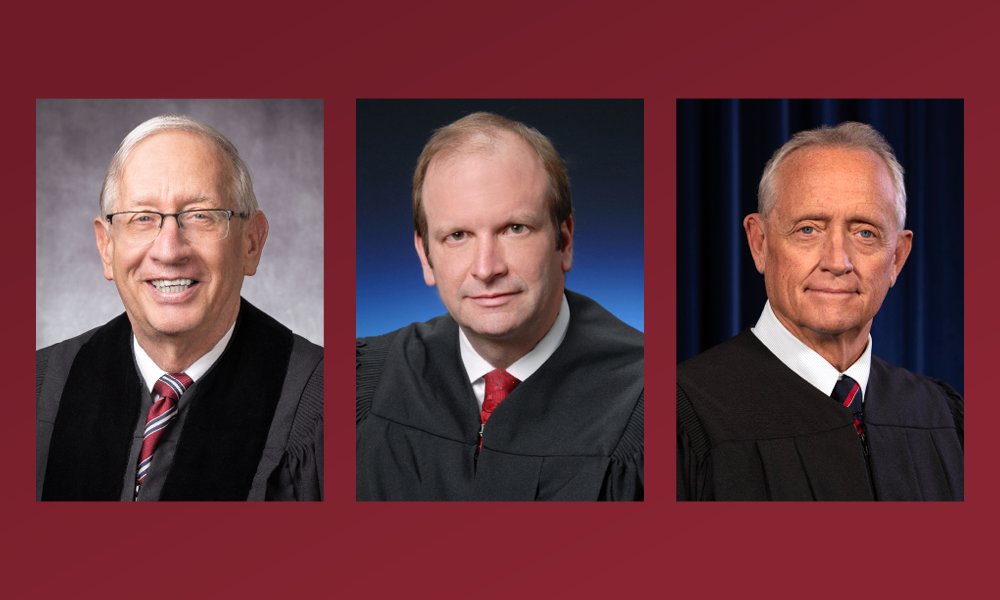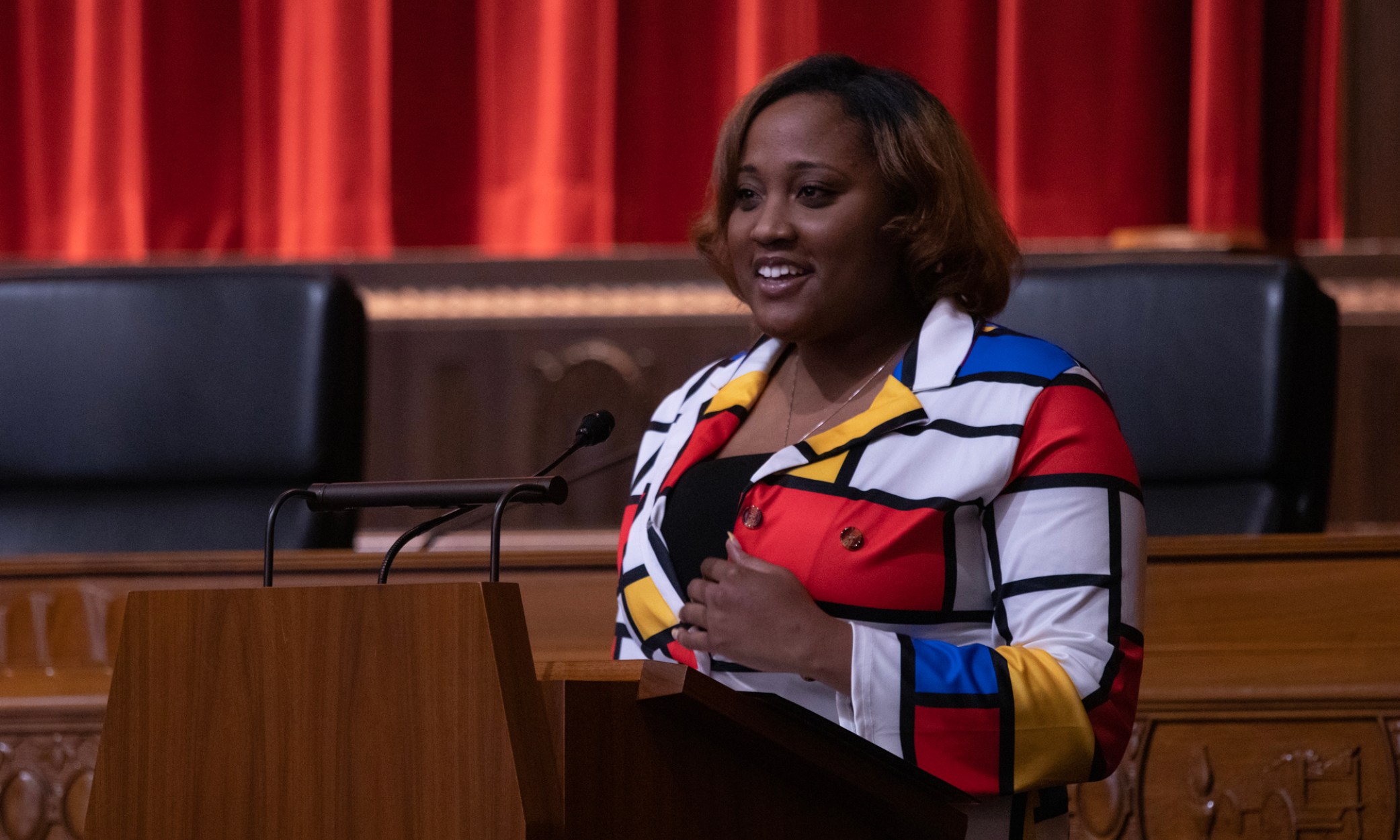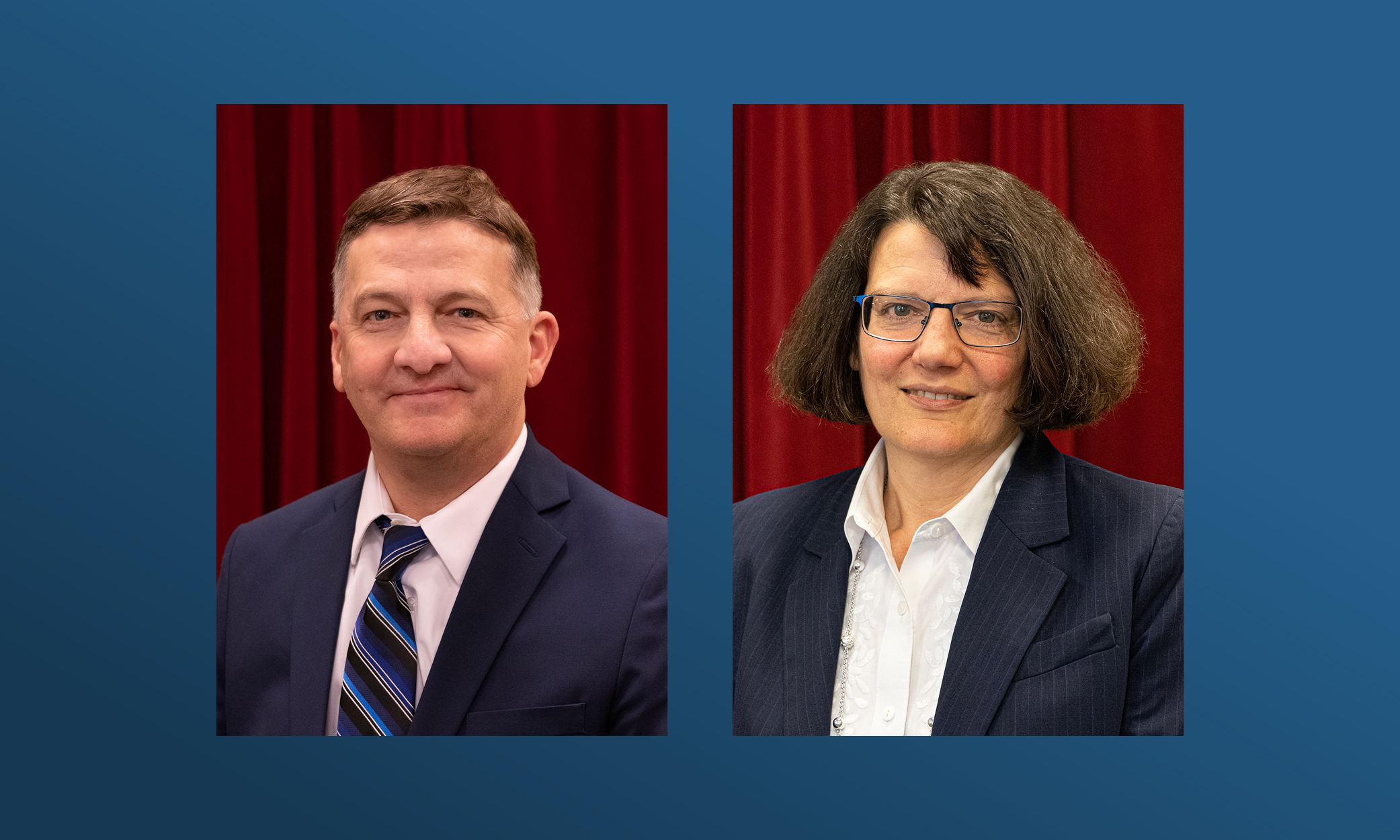A Look Back at 2023
New leadership, significant case rulings, and initiatives on child welfare and reentry shaped the year at the Supreme Court.

This year rang in with an experienced justice taking the helm as chief justice of the state. Chief Justice Sharon L. Kennedy soon initiated a task force to explore issues encountered by people reentering communities after incarceration. Also topping the news this year from the Supreme Court of Ohio were the hiring of an administrative director and a summit to improve child welfare. At the heart of many other events in 2023 was education.
New Chief Justice Establishes Priorities
On Jan. 1, Chief Justice Kennedy, who first joined the Supreme Court 12 years ago, began her term as the Ohio’s 11th chief justice.
At a formal investiture ceremony on Jan. 25, Chief Justice Kennedy described her role leading the state judiciary as the “greatest honor of her life.” She celebrated her accomplishment surrounded by family, friends, and colleagues. To set the stage for her tenure, she shared her goals for strengthening the state justice system.
One of her priorities is for Ohio courts to become more efficient. Chief Justice Kennedy firmly believes in a person’s constitutional right to the timely resolution of court cases. The chief justice wants to work with presiding and administrative judges to reduce the number of criminal cases that are “over-age” – or beyond the six-month timeframe for getting those cases to trial.
“Access to justice is more than just the ability to file a case in court, it includes the right to have cases heard in a timely manner,” Chief Justice Kennedy said.
Among her other initiatives is developing youth mentorship programs to steer juveniles away from the justice system. She also plans to increase support for substance use, mental health, and veterans treatment courts. The goal is for communities to provide supportive services to keep people out of the justice system as well as finding ways for offenders who have served their sentences to “live life restored” through reentry with community help.
“It is a new day at the Ohio Supreme Court and, together, building collaborative problem-solving teams, we will find local solutions for local problems and address the challenges that every court faces,” said Chief Justice Kennedy.
As her inaugural year as chief justice moved forward, she delivered a speech before the Ohio legal community in May at the Ohio State Bar Association (OSBA) Annual Meeting. She applauded the association and its members for working with the courts and the legislature to strengthen legal services. Chief Justice Kennedy also introduced a process for attorneys and parties to request assistance when a timely decision hasn’t occurred in a pending case. She also called for action to address the shortage of attorneys in most counties to increase access to legal guidance for families in underserved areas of Ohio.
In September, Chief Justice Kennedy presented her first annual State of the Judiciary address. Her update to more than 400 judges and court leaders focused on the changes confronting the judiciary and how they can work together to assist their communities.

Justices Patrick F. Fischer (left) and R. Patrick DeWine (middle) began their second terms this year, and Justice Joseph T. Deters joined the Court.
Reelected Justices Start Terms; Longtime Prosecutor Fills Vacancy
Also in January, Justices Patrick F. Fischer and R. Patrick DeWine were sworn in for their second terms on the Supreme Court. Each was first elected to serve on the Court in 2016 and reelected in November 2022.
Before serving on the Court, Justice Fischer was elected twice to the First District Court of Appeals. He has served as president of both the OSBA and Cincinnati Bar Association. He also has been honored with the OSBA’s most prestigious award, the Ohio Bar Medal, for “dedicated service to the legal profession, the community, and humanity.”
Justice DeWine has served at the trial, appellate, and Supreme Court levels in Ohio. Prior to being elected to the Court, he was a judge on the Hamilton County Common Pleas Court and the First District Court of Appeals. As part of his strong commitment to furthering the rule of law through education, Justice DeWine dedicates time to teaching as an adjunct professor at the University of Cincinnati College of Law.
The Court also welcomed a new justice in 2023 – former Hamilton County prosecutor Joseph T. Deters. He was appointed to the seat vacated when Justice Kennedy won her bid for chief justice. Justice Deters was sworn in as the 163rd justice of the Supreme Court in January.
Justice Deters spent much of his professional career as a prosecutor handling high-profile cases in Hamilton County, one of the state’s largest counties. The Supreme Court’s newest justice also has served as Ohio treasurer and Hamilton County clerk of courts.
Court Considers Opioid Settlement, Reagan Tokes Law, and K-9 Bites

Robert W. Horner III, administrative director.
New Administrative Director Named to Lead Court
Robert W. Horner III was selected in the summer by the Supreme Court as the administrative director. Horner began in the role on July 10. As the chief administrative officer of the judicial branch of Ohio government, Horner works closely with the chief justice and justices, and with the judges of the state, to develop and communicate the vision, values, and direction of the Ohio judiciary.
Horner is an attorney who served as senior vice president of corporate legal affairs and secretary for Nationwide Insurance. Following his retirement from Nationwide, he served as executive director and chairman of the board for Honor Flight Columbus.
Prior to those positions, Horner was a partner with the law firm of Kegler, Brown, Hill & Ritter. He also served as chief legal, governance, and compliance officer for several large public companies in the health care business sector.
Task Force to Analyze Needs During Reentry to Society
To explore ways to improve support for people leaving prison or jail and reentering their communities, Chief Justice Kennedy initiated a Supreme Court Reentry Task Force in April.
“Last year nearly 18,000 people in our state emerged from incarceration in prison, and many more from jail – but where were they headed when they were released?” Chief Justice Kennedy asked. “We want to make sure they successfully reenter into community and family life, that the door from incarceration opens to living a life restored and does not become a revolving door.”
The multidisciplinary task force includes state and local agencies, judges, law enforcement, and community health and rehabilitation partners. The chief justice has asked the group to analyze the needs, services, and practices of courts and the reentry population. The task force will identify best practices to aid in reentry with a holistic approach to enhance outcomes for those living a life restored. In addition to prison reentry, the task force will examine local jail release efforts.
Judge Chryssa Hartnett of the Stark County Reentry Court is chairing the task force, which held its first meeting on May 18. The vice chair is Christopher Nicastro, director of Criminal Justice Services at the Ohio Department of Mental Health and Addiction Services. The group is expected to deliver a report with findings and recommendation to the Supreme Court by summer 2024.
Statewide Technology Advances Are Funded by Court
Modernizing court operations across the Ohio judicial branch is a key concern for the Supreme Court, which aids these efforts through the Technology Grant Program. In May, the Court awarded grants for 42 projects at local courts. Among the selected technology projects, courts received funding for new or upgraded case management systems, including e-filing, and to improve security processes.
The grant program is open to Ohio appeals, common pleas, municipal, and county courts. Local courts have received more than $43 million since the program began in 2015.
Groups Work Together to Better Child Welfare
Teams from 52 Ohio counties gathered in March at the Summit on Children to identify ways to expand collaboration among the courts, children services, and other county child welfare partners. The teams included judges, child welfare workers, attorneys, guardians ad litem, and youth participants who shared their personal stories of growing up in the foster care system. The event, organized by the Supreme Court Children & Families Section, featured speakers from across the country who presented best practices to improve outcomes for children and families involved in the child welfare system.
Judicial College Welcomes Educators From Across United States
Ongoing education allows judges, magistrates, and court personnel to share ideas and best practices so they can tackle the challenges that arise in state courts. In August, more than 100 people from the National Association for State Judicial Educators spent three days in Columbus for its annual conference. Leaders in judicial education from across the United States and the Caribbean gathered to learn about new ideas and services to enhance the court experience for the people they serve.
It was the organization’s first event hosted in Ohio, and much of the programming was led by the Supreme Court of Ohio Judicial College. Participants took part in presentations and roundtable discussions. They also saw firsthand the work of Ohio municipal and domestic relations courts during a visit to the Franklin County Government Center.
“It is critical that judges and court personnel stay current on the ever-changing world we have and how that impacts the courts,” said Christy Tull, Judicial College director. “There are changing laws and changing skills needed to be successful and serve the public.”
Ohio judges, magistrates, and other court personnel benefit from many Judicial College courses offered each year. In 2023, the College delivered 354 educational opportunities. That included the valuable four-day New Judges Orientation, presented twice each year to provide information and tools to lawyers transitioning to service as judges. A three-day New Magistrates Orientation in the spring and the fall gives attorneys who have been appointed as magistrates for Ohio courts essential guidance for serving their courts and communities.
Students Experience Justice at Ohio’s Highest Level
The Supreme Court also commits to educating the next generation about the judicial branch and its crucial role in democracy. As part of that mission, the justices travel across the state to hear oral arguments in real cases in front of students. The Off-Site Court Program provides a unique opportunity to see the appellate process at work and, for many who attend, it’s the first time they have stepped into a court proceeding. The justices made two trips this year – to Hamilton County and Jefferson County.
The first stop was Hamilton County in April. Students and teachers from six local high schools, Xavier University, and the University of Cincinnati (UC) joined the justices at the UC College of Law to hear attorneys argue three cases.
In October, approximately 450 students from Jefferson and Harrison counties visited Buckeye Local High School in Rayland, Ohio, to watch the Supreme Court in action. It was the first time off-site court was held Jefferson County.
The program, which began in 1987, has now traveled to 73 of Ohio’s 88 counties, allowing more than 34,000 students to see the state high court up close. The event also encourages young people to consider legal careers, which is especially needed in counties without enough attorneys.
Forms, Toolkits Designed for Local Courts and Partners
Through the Office of Court Services, the Supreme Court compiles guidance to assist trial and appellate courts. This year, one major shift for local courts, prosecutors, and law enforcement involved a new focus on the expanded victim rights and protections detailed in the Ohio Constitution and state legislation, which went into effect in April. The expansion was part of what’s often called Marsy’s Law or the Ohio Crime Victims’ Bill of Rights. The Court developed a form to help crime victims with an aspect of the law. The Crime Victim Restitution Amount Summary Form provides guidance for victims seeking compensation for economic loss from the criminal or delinquent act.
Three toolkits were created in 2023 for local courts:
- “Developing an Effective School Attendance Program”: Details how schools, courts, and community partners can work together on issues, such as unreliable transportation or mental health struggles, that can keep a child from being in school. Developed with the Ohio Department of Education.
- “Custody Evaluations Toolkit for Judicial Use”: Informs courts about their responsibilities, best practices, laws, and rules for decision-making in custody disputes to help families resolve conflicts.
- “Judicial Guide to Guardian ad Litem Programs”: Identifies strategies courts can use to recruit and educate guardians ad litem and highlights best practices for increasing accountability and improving performance.
Administrative Updates Serve Legal Community
For the first time, attorney registration became a completely online process via the Supreme Court website. The online application also was updated, and organizations were able to make group payments online. Responses available for questions of gender, race, and ethnicity have been expanded and are no longer mandatory. In addition, attorneys are asked to identify other states where they are licensed to practice law, whether they have professional liability insurance, and if there is a succession plan in the event the attorney is permanently or temporarily unable to manage their caseload.
Attorney registration fees were adjusted after 16 years at a set amount. The increases are being phased in over two registration periods, effective with the 2023-2025 registration period, which started Sept. 1. The fee for this timeframe was $400. For the 2025-2027 period, the fee will be $450.
The last increase was in 2007. Cost-saving measures by the Office of Attorney Services prevented higher fees after 2017, which was the end of the projected 10-year window for the prior increase to last. Ohio currently ranks as having one of the lowest attorney registration fees in the country. Ohio attorneys also pay registration only every two years, compared with other states where fees are charged annually. Attorney registration fees fund processing registrations, maintaining attorney records, investigating complaints of judicial or attorney misconduct, reimbursing victims of attorney theft, and other attorney services.
Also launched this year, organizations that develop continuing legal education (CLE) for Ohio attorneys can apply for course approval online. On the Supreme Court website, CLE sponsors complete an online application and pay related fees through the sponsor portal. Bar associations, law firms, educational organizations, and public agencies are among those who sponsor CLE courses.

Casey McCormick, a college graduate planning to pursue a legal career, inspires eighth graders to consider becoming an attorney.
Opportunities in Legal Profession Shared
In February, young people bound for careers in law and justice spoke at the Court about the experiences that sparked their interest in a legal career, their dreams, and the determination to achieve. A current high school student, a college graduate preparing for law school, and a lawyer at Jones Day in Cleveland shared their thoughts with the justices and eighth graders at the program, called “Opening Doors to Careers in Law.”
The speakers were students or past participants of the Law and Leadership Institute, which started in 2008 as a summer initiative of the Court to inspire and prepare young people from underserved communities to consider careers in the legal field. This year’s event was held in celebration of Black History Month.
Portrait Honors Justice’s Service to Law
The life and career of a former justice was celebrated in June with a majestic portrait dedication ceremony at the Supreme Court. Justice Andrew “Andy” Douglas left his mark on many Ohioans as an attorney and a judge dedicated to solving legal problems for 61 years. Family, friends, and colleagues gathered to pay tribute to the legacy of Douglas, who passed away at 89 in September 2021. Douglas served on the Court from 1985 to 2002. His wife donated the portrait to the Court for permanent display at the Moyer Judicial Center.

Robert Vaughn is Clerk of the Court, and Diane Brey heads the office that researches complex legal issues for the justices.
Court Hires for Leadership Roles
A few senior leader positions were filled at the Supreme Court this year. Each person has lists of impressive career accomplishments, including prior service with the Court.
Clerk of Courts: One of Robert Vaughn’s first jobs as a lawyer was working as case management counsel for the clerk of the Supreme Court. Vaughn has returned, bringing 25 years of wide-ranging experience in the legal profession. His swearing in was held in March.
As Clerk of the Court, Vaughn and his staff manage all cases and documents filed with the Supreme Court, from when they are received until the case or matter is completed. The office also prepares and issues Court orders, schedules oral arguments, and helps attorneys and the public with procedural questions about appellate cases.
Director, Office of Legal Resources: Earlier in her career, Diane Brey was a judicial attorney at the Supreme Court, building valuable experience working for former Justice Robert Cupp. Brey returned to the Court in May to lead the Office of Legal Resources.
Brey gained impressive legal credentials along the way during time in both private practice and public service, including the Attorney General’s Office and the Governor’s Office. While at the Attorney General’s Office, she argued several cases before the Court.
CREDITS:
Design: Ely Margolis
Web: Erika Lemke
Video Stories: Csaba Sukosd
